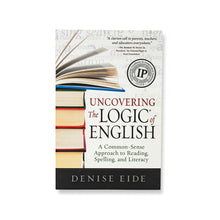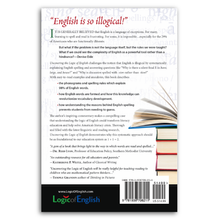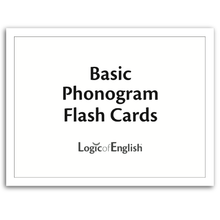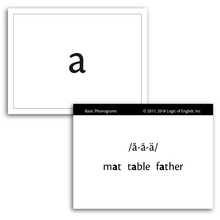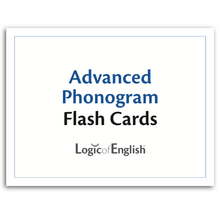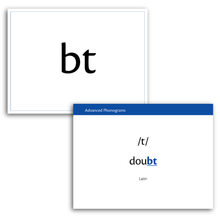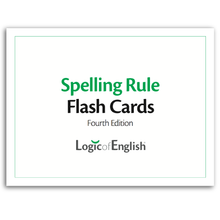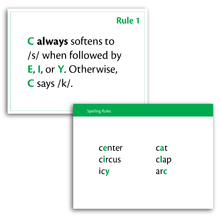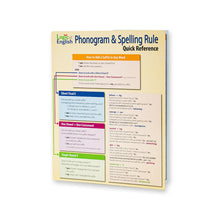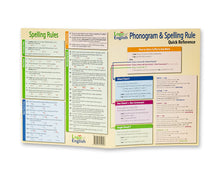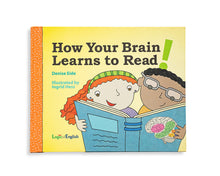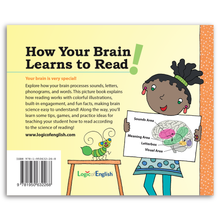Systematic Phonics Skills
Alphabetic Principle
SP.1.a | Demonstrate an understanding that a phonogram is a written picture of a sound.
SP.1.b | Demonstrate an understanding that a phonogram may be written with one, two, three, or four letters.
SP.1.c | Count the number of phonograms in a word.
SP.1.d | Count the number of sounds made by a phonogram.
Lowercase Single-Letter Phonograms
SP.2.a | Read the sound of the single-letter phonograms that say only one sound.
- b, d, f, h, j, k, l, m, n, p, r, t, v, w, z
SP.2.b | Read ALL the sounds, in order of frequency, of the single-letter phonograms that say more than one sound.
- a, c, e, g, i, o, s, u, x, y
SP.2.c | Recognize and match the lowercase a-z phonograms as they appear in a variety of computer fonts.
SP.2.d | Write the lowercase a-z phonograms.
SP.2.e | Recognize and match the lowercase a-z phonograms in a bookface font to their handwritten forms.
The Phonogram QU
SP.3.a | Read the sounds of the multi-letter phonogram qu.
SP.3.b | Identify QU as a multi-letter phonogram in a word.
Uppercase Letters
SP.4.a | Match lowercase and uppercase form of each letter as they appear in a variety of fonts.
SP.4.b | Read ALL the sounds, in order of frequency, of the single-letter phonograms from the uppercase forms.
CVC Words
SP.5.a | Decode CVC words that use only single-letter phonograms saying their first sounds.
SP.5.b | Decode words with the multi-letter phonogram qu.
Consonant Blends
SP.6.a | Blend two consonants in isolation.
SP.6.b | Blend three consonants in isolation.
SP.6.c | Decode words with consonant blends that use only single-letter phonograms saying their first sounds.
More One-Syllable Words
SP.7.a | Decode one-syllable words that include the phonogram S saying its second sound /z/.
SP.7.b | Decode one-syllable words beginning with an uppercase letter.
Letter Names
SP.8.a | Identify the name of each letter.
Consonants and Vowels
SP.9.a | Demonstrate an understanding that consonants are sounds blocked by the lips, tongue, or teeth, and that they usually cannot be sung or controlled for volume.
SP.9.b | Demonstrate an understanding that vowels are sounds which can be sung AND can be controlled for volume, and that they are NOT blocked by the lips, tongue, or teeth.
SP.9.c | Identify whether each sound of a single-letter phonogram is a consonant sound or a vowel sound.
SP.9.d | Identify whether each sound of a multi-letter phonogram is a consonant sound or a vowel sound.
Short Vowels
SP.10.a | Identify the short vowel sounds of the six single-letter vowels.
SP.10.b | Mark vowels that are saying their short sound with a breve.
SP.10.c | Read the short sound of single-letter vowels marked with a breve.
SP.10.d | Recognize that the short sounds are the most common sounds of the single-letter vowels.
Long Vowels
SP.11.a | Identify the second vowel sound of the six single-letter vowels as a long sound.
SP.11.b | Mark vowels that are saying their long sound with a macron.
SP.11.c | Read the long sound of single-letter vowels marked with a macron.
SP.11.d | Identify the two long sounds of U.
SP.11.e | Decode one-syllable words that follow the rule A E O U usually say their long sounds at the end of the syllable.
SP.11.f | Decode words that follow the rule I and O may say /ī/ and /ō/ when followed by two consonants.
SP.11.g | Decode words that follow the silent final E rule The vowel says its long sound because of the E.
SP.11.h | Identify the reason a single-letter vowel is saying its long sound in a given word.
Broad Vowels
SP.12.a | Identify the broad vowel sounds for A, O, and U.
SP.12.b | Mark vowels that are saying their broad sound with two dots.
SP.12.c | Read the broad sound of single-letter vowels marked with two dots.
SP.12.d | Decode one-syllable words with a broad vowel sound.
SP.12.e | Decode one-syllable words that follow the rule When a word ends with the phonogram A, it says /ä/.
SP.12.f | Decode one-syllable words that follow the rule A may also say /ä/ after a W.
SP.12.g | Decode one-syllable words that follow the rule A may also say /ä/ before an L.
SP.12.h | Identify the reason a single-letter vowel is saying its broad sound in a given word.
Schwa
SP.13.a | Demonstrate an understanding that schwa is a lazy vowel sound where the mouth does not open as far and the sound is quieter and distorted.
SP.13.b | Demonstrate an understanding that Any vowel may say one of the schwa sounds, /ŭ/ or /ĭ/, in an unstressed syllable.
SP.13.c | Demonstrate an understanding that Any vowel may say one of the schwa sounds, /ŭ/ or /ĭ/, in an unstressed word.
SP.13.d | Recognize the symbol for schwa, ə.
SP.13.e | Identify a schwa sound in a given word.
SP.13.f | Decode one-syllable words with the schwa sound.
SP.13.g | Decode words that follow the rule O may say /ŭ/ in a stressed syllable next to W, TH, M, N, or V.
SP.13.h | Decode words that follow the rule AR and OR may say their schwa sound, /er/, in an unstressed syllable.
Vowel Types
SP.14.a | Identify if a vowel is a single-letter vowel, a multi-letter vowel, or an R-controlled vowel.
SP.14.b | Identify whether a single-letter vowel in a given word is open or closed.
I & Y
SP.15.a | For words ending in Y, identify if the final Y is a single-vowel Y or a part of a multi-letter phonogram.
SP.15.b | Decode words that follow the rule I and Y may say /ĭ/ or /ī/ at the end of the syllable.
SP.15.c | Identify whether an I or Y at the end of a syllable in the middle of a word is saying its short sound or its long sound.
SP.15.d | Decode words that follow the rule When a one-syllable word ends in a single vowel Y, it always says /ī/.
SP.15.e | Explain how the rule English words do not end in I, U, V, or J applies to the spelling of words such as fly, cry, and my.
SP.15.f | Decode words that follow the rule Y says /ē/ only in an unstressed syllable at the end of a multi-syllable word.
SP.15.g | Decode words that follow the rule I may say /ē/ with a silent final E.
SP.15.h | Decode words that follow the rule I may say /ē/ at the end of a syllable.
SP.15.i | Decode words that follow the rule I may say /ē/ at the end of foreign words.
SP.15.j | Decode words with a suffix added to a word that ends with single-vowel Y.
Syllables
SP.16.a | Count the number of syllables by humming the word.
SP.16.b | Count the number of syllables by counting the number of times the mouth drops open to form a vowel sound.
SP.16.c | Count the number of syllables in a written word by counting the number of written vowels.
SP.16.d | Demonstrate an understanding that all syllables have one and only one vowel.
Syllable Stress
SP.17.a | Identify the stressed syllable in the word by saying the word aloud and feeling on which syllable the chin drops open the furthest.
SP.17.b | Demonstrate an understanding that in spoken English different syllables have different amounts of stress.
SP.17.c | Demonstrate an understanding that a stressed syllable is said more loudly than an unstressed syllable.
SP.17.d | Identify the unstressed syllable in words that include a schwa by communicating an understanding that schwa is an unstressed vowel.
SP.17.e | Apply knowledge of the phonograms and spelling rules to explain why a word is spelled a certain way.
SP.17.f | Apply the rule A E O U usually say their long sounds at the end of the syllable to divide the syllables in a word with a single-letter vowel.
SP.17.g | Apply the rule I and O may say /ī/ and /ō/ when followed by two consonants to divide the syllables in a word with a single-letter I or O.
SP.17.h | Demonstrate an understanding that syllables commonly divide between two consonants.
Hard & Soft C & G
SP.18.a | Decode words that follow the rule C always softens to /s/ when followed by E, I, or Y. Otherwise, C says /k/.
SP.18.b | Identify the reason C is saying /k/ or /s/ in a given word.
SP.18.c | Decode words that follow the rule G may soften to /j/ only when followed by E, I, or Y. Otherwise, G says /g/.
SP.18.d | Identify the reason G is saying /g/ or /j/ in a given word.
Words With Double Consonants
SP.19.a | Decode words that follow the rule We often double F, L, and S after a single, short or broad vowel at the end of a base word. Occasionally other letters also are doubled.
SP.19.b | Decode words that Double the last consonant when adding a vowel suffix.
Multi-Letter Phonograms That Say Only One Sound
SP.20.a | Read the sound of the multi-letter phonograms that say only one sound.
- ai, ar, au, aw, ay, bu, cei, ci, ck, dge, ear, ee, er, gn, ie, igh, ir, kn, ng, oa, oi, or, oy, ph, sh, tch, ti, ui, ur, wh, wor, wr
SP.20.b | Decode words that include the multi-letter phonogram ___ (see above).
SP.20.c | Explain how the rule English words do not end in I, U, V, or J applies to the phonograms OI, OY, AU, AW, UI, AI, and AY.
SP.20.d | Decode words that follow the rule DGE is used only after a single vowel which says its short sound.
SP.20.e | Decode words that follow the rule CK is used only after a single vowel which says its short sound.
SP.20.f | Decode words that follow the rule TCH is used only after a single vowel which says its short or broad sound.
Multi-Letter Phonograms That Say Multiple Sounds
SP.21.a | Read ALL the sounds, in order of frequency, of the multi-letter phonograms that say more than one sound.
- augh, ch, ea, ed, ei, eigh, es, ew, ey, gu, oe, oo, ou, ough, ow, si, th
SP.21.b | Decode words that include the multi-letter phonogram ___ (see above).
SP.21.c | Decode words with phonograms that say more than one sound. Recognize the possibilities and try each of the sounds until the word makes sense.
Phonogram Mastery
SP.22.a | Read ALL the sounds, in the order of frequency, of each of the 75 Basic Phonograms.
SP.22.b | Read ALL the sounds, in the order of frequency, and state the spelling hints for the Basic Phonograms that have one.
Plurals
SP.23.a | Decode plural words ending in -S.
SP.23.b | Decode plural words ending in -ES.
SP.23.c | Decode plural words with an irregular spelling.
Past Tense
SP.24.a | Decode past tense words with the suffix -ED.
Additional Reasons for a Silent Final E
SP.25.a | Decode words that have a Silent Final E because English words do not end in V or U.
SP.25.b | Decode words that have a Silent Final E because The C says /s/ and the G says /j/ because of the E.
SP.25.c | Decode words that have a Silent Final E because Every syllable must have a written vowel.
SP.25.d | Decode words that have a Silent Final E to keep singular words that end in the letter S from looking plural.
SP.25.e | Decode words that have a Silent Final E to make the word look bigger.
SP.25.f | Decode words that have a Silent Final E to make the TH say its voiced sound.
SP.25.g | Decode words that have a Silent Final E to clarify meaning.
SP.25.h | Decode words that have an unseen reason for a silent final E.
SP.25.i | Explain why the silent final E is needed in a given word.
SP.25.j | Decode words with a suffix added after a silent final E.
SP.25.k | Decode words that dropped silent E before the suffix was added.
True Exceptions
SP.26.a | Decode words with an exception to the phonograms or spelling rules. Identify which parts of the word follow the rules, and identify the exception.
Compound Words
SP.27.a | Decode two one-syllable words using previously taught phonograms and spelling rules, then combine the words and decode the compound word.
SP.27.b | Decode compound words using previously taught phonograms and spelling rules.
Two-Syllable Words
SP.28.a | Decode two-syllable words with short, single-letter vowels and/or previously taught multi-letter phonograms.
SP.28.b | Decode two-syllable words that include a long sound because of the rule A E O U usually say their long sounds at the end of the syllable.
SP.28.c | Decode two-syllable words where A and U say their broad sounds.
SP.28.d | Decode two-syllable words with a schwa sound.
SP.28.e | Decode two-syllable words with double consonants in the middle of the word.
Silent Letters
SP.29.a | Decode words with a silent L.
Three- Four- and Five-Syllable Words
SP.30.a | Decode three-syllable words using previously taught phonograms and spelling rules.
SP.30.b | Decode four-syllable words using previously taught phonograms and spelling rules.
SP.30.c | Decode five-syllable words using previously taught phonograms and spelling rules.
Advanced Phonograms
SP.31.a | Recognize that an unfamiliar spelling in a word may be an advanced phonogram.
SP.31.b | Identify ___ as an Advanced Phonogram. Demonstrate familiarity, but not necessarily mastery, of its sound(s).
- aa, ae, ah, ai, aigh, au, ay, bt, cc, ce, cu, e, eau, ée, ei, eo, et, eu, eur, ge, gh, gi, gn, j, kh, ll, mb, mn, ñ, oe, oi, ot, our, pn, ps, pt, qu, rh, s, sc, sch, sci, th, ut, xi, yr, z, zz
Contractions
SP.32.a | Decode contractions.
SP.32.b | Identify the two words represented in a contraction.
Assimilation & Allophones
SP.33.a | Recognize that in speech sounds that are next to one another in a word often assimlate.
SP.33.b | Decode words with sounds that assimilate.
SP.33.c | Identify which sounds in a word are assimilating and describe why, using descriptions of how the individual sounds are formed in the mouth.
SP.33.d | Demonstrate an understanding that there are shades of sounds, and that a given phoneme may be pronounced slightly differently based upon what other sounds surround it in a word.

